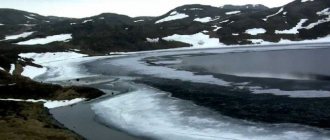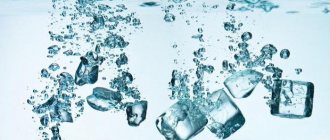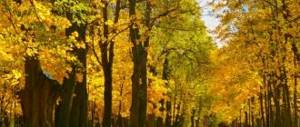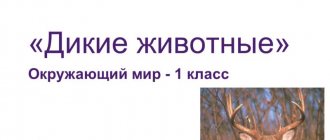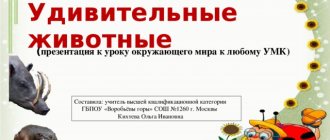Presentation 4th grade underground wealth of Russia
How to make a presentation step by step
- Prepare your text by typing it into a Word document. Break it down into points (hereinafter referred to as slides).
- Prepare high-quality pictures on the topic for each item and save them in a folder.
- Open Power Point. Click "Home" - "Create Slide". Add the required number of blank slides to match the number of points in your text. If the slide needs to be deleted, press Del. Slides can be rearranged by dragging with the mouse.
- If the standard layout does not suit you, you can select the one you need by right-clicking on the slide and selecting “Layout”.
- Change the color and design of the page, you can find them in the “Design” - “Themes” tab. You will find a large number of color options.
- Add text by clicking on the required block and copying the text from the document.
- Add a drawing. To do this, click “Insert” - “Drawing” and find the drawing you need.
- To insert a table, click “Insert” - “Table” and draw the required number of rows and columns, then fill it out.
- All that remains is to apply effects so that the slides smoothly replace each other. Go to “Animation” - “Transition Scheme” and select the option you like. This option will only apply to this slide; you must set the transition scheme again for each slide.
- Effects can be applied to appearing text and pictures. You need to select an object (text or picture), click the “Animation” tab - “Animation settings”. From all the options, select the one you need, the effects are displayed instantly.
- In the settings, adjust the necessary parameters by going to “Slide Show” - “Demonstration Settings”.
- To show the presentation, select “Slide Show” - “Start from the Beginning”, or press F5.
Report 4th grade our underground riches
The subsoil of Russia is rich in minerals - formations of minerals that are used in the economy. Some underground wealth is found at great depths, while others are mined from the surface of the earth. Mineral resources are used for different purposes: some are used in construction (limestone, granite), others are used as fuel (oil, peat, coal, natural gas), people smelt various metals from ores, make fertilizers from salts, and people use them as food. Small accumulations of underground wealth are called a deposit, and if the accumulation area is large, a basin. Deposits of brown and hard coal are numerous; it can be found in the Moscow basin, Kuznetsk basin, as well as Tunguska, Lensk, Kansko-Achinsk, etc.
Underground riches:
- Granite is the most durable rock. It has a crystalline structure, the color tone depends on the feldspars (the bulk of the crystals that make up the mineral). The color is often gray or red, less often ash, green, white. Durable, weather resistant. Used for construction purposes. Granite deposits: Khabarovsk Territory, Ural, Transbaikalia, Arkhangelsk Region.
- Limestone is a yellow, white or gray rock. The structure can be crystalline, marble-like; dense with a crystalline structure, but it is difficult to notice with the naked eye; coral and shellfish, consisting of skeletal parts of organisms; chalk; calcareous tuffs. Limestones are mined in the Caucasus, the Urals and Siberia.
- Fossil fuels are formed by organisms that accumulate carbon in their tissues under the influence of solar energy. Peat appears when bogs and swamps become overgrown, when dead plants fill the bottom of reservoirs. Coal was formed due to the extensive vegetation that grew in river deltas and off the coast of the seas. If the sea flooded the forests, the wood underwent a special type of decomposition. Depending on the vegetation, different types of coal were formed. Natural gas is colorless and has a characteristic odor. It produces heat when burned, therefore it is used to heat homes; various substances (plastics, artificial fiber) are obtained from the gas. Oil is processed into kerosene, gasoline, and fuel oil. It is a raw material for the chemical industry and is needed for transport. Oil is pumped out of the ground using pumps and pipes.
- Ore rocks are metallic and non-metallic. Suitable for industrial and commercial use. The Kola Peninsula, Altai, and the Urals are rich in ores.
- Gold and platinum are noble metals of great value. Gold deposits are concentrated in Eastern Siberia and Yakutia, platinum - in the Urals.
- Diamond is an incredibly hard mineral and is of great value. Deposits in Siberia, the Urals, and Yakutia.
Composition and types of iron ore
Iron ore is classified according to its iron content. The amount of iron in the ore can range from 16% to 70%. The less iron, the more side impurities. Ore with a large amount of impurities requires more processing and the process of obtaining iron from it is too labor-intensive.
Depending on the amount of iron, the ore is very rich, rich, medium and poor.
Among the by-products there can be very dangerous ones. These are sulfur, arsenic, phosphorus.
There are several types of this mineral.
The richest in amount of iron is red iron ore . The breed got its name because of its reddish color. Red iron ore contains 70% iron and very few various impurities. It contains few harmful substances.
Brown iron ore contains about 25% iron. This rock is often used in the production of cast iron because it is easy to process.
Magnetic ore contains large amounts of iron , but it is a very rare rock.
Siderites are the poorest in iron composition . Their reserves are also small.
Message on the topic of our underground wealth, grade 4
In terms of the number of mineral deposits, Russia occupies a leading position. There are about two hundred thousand deposits in the country. 60% of gas reserves, 30% of the world's coal reserves and 20% of oil are concentrated in our country. Significant mineral resources are cobalt, potassium salts, iron, oil, coal, and natural gas. The Kola Peninsula is rich in iron ore, gas and oil occur in the Volga-Ural basin and on the West Siberian plate. Brown and hard coal are located in the Kansk-Achinsk basin, Lensky, Tungussky, Kuzbass, and the Vorkuta region.
Mountain regions are rich in ore rocks: copper - in Transbaikalia and the Urals, zinc, lead - in Altai, the Northern Caucasus and the Primorsky Territory, tin - in the Eastern part of Siberia and the Far East, bauxite - in the Krasnoyarsk Territory and the Northern Urals. There are gold deposits in Yakutia, Eastern Siberia and the northern part of the Far East, and platinum deposits in the Urals. The diamond deposit is located in the western part of Yakutia, the apatite deposit is on the Kola Peninsula. The Far East is rich in graphite, and the Volga region and the Urals are rich in potassium salt. Russia is the world leader in the production of diamonds, natural gas and oil.
Thanks to continuous processes that took place many years ago, deposits of underground wealth appeared in Russia. A large number of people and companies are involved in their research and production. Minerals are used for their intended purpose in economics and industry; they help develop production and boost the economy.
Deposits of Russia
Iron ores lie in the crystalline foundation of the platforms (Kola Peninsula), and oil and gas deposits are located in sedimentary covers (Volga-Ural Basin, West Siberian Plate). The largest deposits of hard and brown coal are located in the Vorkuta region, in the Donetsk basin, Kuzbass, Tunguska, Lensk, Kansk-Achinsk basins.
Rice. 2. Kansk-Achinsk basin.
Iron ores occur in the area of the Kursk magnetic anomaly, the Aldan shield, the Angaro-Pitsky and Angaro-Ilimsky regions, nickel ores - on the Kola Peninsula, and polymetallic ores - near Norilsk.
Mountain areas are rich in ore minerals. Here are deposits of non-ferrous and rare metal ores: copper (Ural, Transbaikalia), lead, zinc (North Caucasus, Primorsky Territory, Altai), tin (Far East, Eastern Siberia), bauxite (Northern Urals, Krasnoyarsk Territory).
There are gold deposits in Eastern Siberia, Yakutia, and the north of the Far East, and platinum deposits in the Urals.
In the west of Yakutia there is a deposit of diamonds, on the Kola Peninsula - apatites, in the Volga region and in the Urals - potassium salts, and in the Far East - graphite.
Rice. 3. Diamond deposits in Yakutia.
